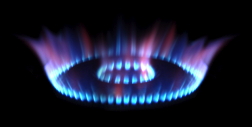Home > Press > New Mechanism Converts Natural Gas to Energy Faster, Captures CO2
 |
Abstract:
Chemical engineering researchers have identified a new mechanism to convert natural gas into energy up to 70 times faster, while effectively capturing the greenhouse gas carbon dioxide (CO2).
New Mechanism Converts Natural Gas to Energy Faster, Captures CO2
Raleigh, NC | Posted on May 7th, 2013"This could make power generation from natural gas both cleaner and more efficient," says Fanxing Li, co-author of a paper on the research and an assistant professor of chemical and biomolecular engineering at North Carolina State University.
At issue is a process called chemical looping, in which a solid, oxygen-laden material - called an "oxygen carrier" - is put in contact with natural gas. The oxygen atoms in the oxygen carrier interact with the natural gas, causing combustion that produces energy.
Previous state-of-the-art oxygen carriers were made from a composite of inert ceramic material and metal oxides. But Li's team has developed a new type of oxygen carrier that include a "mixed ionic-electronic conductor," which effectively shuttles oxygen atoms into the natural gas very efficiently - making the chemical looping combustion process as much as 70 times faster. This mixed conductor material is held in a nanoscale matrix with an iron oxide - otherwise known as rust. The rust serves as a source of oxygen for the mixed conductor to shuttle out into the natural gas.
In addition to energy, the combustion process produces water vapor and CO2. By condensing out the water vapor, researchers are able to create a stream of concentrated CO2 to be capture for sequestration.
Because the new oxygen carrier combusts natural gas so much more quickly than previous chemical looping technologies, it makes smaller chemical looping reactors more economically feasible - since they would allow users to create the same amount of energy with a smaller system.
"Improving this process hopefully moves us closer to commercial applications that use chemical looping, which would help us limit greenhouse gas emissions," Li says.
####
For more information, please click here
Contacts:
Matt Shipman
919-515-6386
Copyright © North Carolina State University
If you have a comment, please Contact us.Issuers of news releases, not 7th Wave, Inc. or Nanotechnology Now, are solely responsible for the accuracy of the content.
| Related Links |
| Related News Press |
News and information
![]() Researchers develop molecular qubits that communicate at telecom frequencies October 3rd, 2025
Researchers develop molecular qubits that communicate at telecom frequencies October 3rd, 2025
![]() Next-generation quantum communication October 3rd, 2025
Next-generation quantum communication October 3rd, 2025
![]() "Nanoreactor" cage uses visible light for catalytic and ultra-selective cross-cycloadditions October 3rd, 2025
"Nanoreactor" cage uses visible light for catalytic and ultra-selective cross-cycloadditions October 3rd, 2025
Discoveries
![]() Researchers develop molecular qubits that communicate at telecom frequencies October 3rd, 2025
Researchers develop molecular qubits that communicate at telecom frequencies October 3rd, 2025
![]() Next-generation quantum communication October 3rd, 2025
Next-generation quantum communication October 3rd, 2025
![]() "Nanoreactor" cage uses visible light for catalytic and ultra-selective cross-cycloadditions October 3rd, 2025
"Nanoreactor" cage uses visible light for catalytic and ultra-selective cross-cycloadditions October 3rd, 2025
Interviews/Book Reviews/Essays/Reports/Podcasts/Journals/White papers/Posters
![]() Spinel-type sulfide semiconductors to operate the next-generation LEDs and solar cells For solar-cell absorbers and green-LED source October 3rd, 2025
Spinel-type sulfide semiconductors to operate the next-generation LEDs and solar cells For solar-cell absorbers and green-LED source October 3rd, 2025
![]() Rice membrane extracts lithium from brines with greater speed, less waste October 3rd, 2025
Rice membrane extracts lithium from brines with greater speed, less waste October 3rd, 2025
Environment
![]() Researchers unveil a groundbreaking clay-based solution to capture carbon dioxide and combat climate change June 6th, 2025
Researchers unveil a groundbreaking clay-based solution to capture carbon dioxide and combat climate change June 6th, 2025
![]() Onion-like nanoparticles found in aircraft exhaust May 14th, 2025
Onion-like nanoparticles found in aircraft exhaust May 14th, 2025
![]() SMART researchers pioneer first-of-its-kind nanosensor for real-time iron detection in plants February 28th, 2025
SMART researchers pioneer first-of-its-kind nanosensor for real-time iron detection in plants February 28th, 2025
Energy
![]() Sensors innovations for smart lithium-based batteries: advancements, opportunities, and potential challenges August 8th, 2025
Sensors innovations for smart lithium-based batteries: advancements, opportunities, and potential challenges August 8th, 2025
![]() Simple algorithm paired with standard imaging tool could predict failure in lithium metal batteries August 8th, 2025
Simple algorithm paired with standard imaging tool could predict failure in lithium metal batteries August 8th, 2025
Battery Technology/Capacitors/Generators/Piezoelectrics/Thermoelectrics/Energy storage
![]() Rice membrane extracts lithium from brines with greater speed, less waste October 3rd, 2025
Rice membrane extracts lithium from brines with greater speed, less waste October 3rd, 2025
![]() Sensors innovations for smart lithium-based batteries: advancements, opportunities, and potential challenges August 8th, 2025
Sensors innovations for smart lithium-based batteries: advancements, opportunities, and potential challenges August 8th, 2025
![]() Deciphering local microstrain-induced optimization of asymmetric Fe single atomic sites for efficient oxygen reduction August 8th, 2025
Deciphering local microstrain-induced optimization of asymmetric Fe single atomic sites for efficient oxygen reduction August 8th, 2025
|
|
||
|
|
||
| The latest news from around the world, FREE | ||
|
|
||
|
|
||
| Premium Products | ||
|
|
||
|
Only the news you want to read!
Learn More |
||
|
|
||
|
Full-service, expert consulting
Learn More |
||
|
|
||








